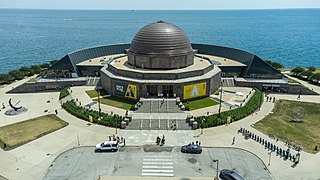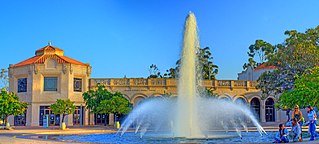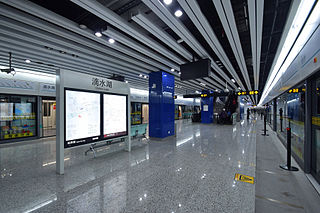
The Adler Planetarium is a public museum in Chicago, Illinois, dedicated to astronomy and astrophysics. It was founded in 1930 by local businessman Max Adler. Located on the northeastern tip of Northerly Island on Lake Michigan, the Adler Planetarium was the first planetarium in the United States. It is part of Chicago's Museum Campus, which includes the John G. Shedd Aquarium and The Field Museum. The Planetarium's mission is to inspire exploration and understanding of the universe.

Kohn Pedersen Fox Associates (KPF) is an American architectural firm that provides architecture, interior, programming and master planning services for clients in both the public and private sectors. KPF is one of the largest architecture firms in New York City, where it is headquartered.

The Carnegie Science Center is one of the four Carnegie Museums of Pittsburgh, Pennsylvania. It is located in the Chateau neighborhood. It is located across the street from Acrisure Stadium.

The Manitoba Museum, previously the Manitoba Museum of Man and Nature, is a human and natural history museum in Winnipeg, Manitoba, as well as the province's largest, not-for-profit centre for heritage and science education.

James Stewart Polshek was an American architect based in New York City. He was the founder of Polshek Partnership, the firm at which he was the principal design partner for more than four decades. He worked as design counsel to the legacy firm Ennead Architects, as well as being actively engaged as design lead on multiple projects.

The Fleet Science Center is a science museum and planetarium in Balboa Park, located in San Diego, California. It is at the east end of the El Prado Drive walkway, next to the Bea Evenson Fountain and plaza in central Balboa Park.

Telus World of Science Edmonton (TWOSE) is a broad-based science centre in Edmonton, Alberta, Canada, operated by the (non-profit) Edmonton Space & Science Foundation. The centre is located on the southwest corner of Coronation Park in the neighborhood of Woodcroft. The science centre houses 144,430 sq. ft. of public space and is the largest science centre in Western Canada. It is currently a member of both the Association of Science-Technology Centers (ASTC) and the Canadian Association of Science Centres (CASC).

The McLaughlin Planetarium is a former working planetarium whose building occupies a space immediately to the south of the Royal Ontario Museum in Toronto, at 100 Queen's Park. Founded by a grant from philanthropist Colonel R. Samuel McLaughlin, the facility was opened to the public on October 26, 1968. It had, for its time, a state-of-the-art electro-mechanical Zeiss planetarium projector that was used to project regular themed shows about the stars, planets, and cosmology for visitors. By the 1980s the planetarium's sound-system and domed ceiling were used to display dazzling music-themed laser-light shows. The lower levels of the planetarium contained a gallery called the "Astrocentre" that featured space-related exhibits, related artifacts on the history of astronomy and was also home of the world's first commercial Stellarium

The Rose Center for Earth and Space is a part of the American Museum of Natural History in New York City. The Center's complete name is The Frederick Phineas and Sandra Priest Rose Center for Earth and Space. The main entrance is located on the northern side of the museum on 81st Street near Central Park West in Manhattan's Upper West Side. Completed in 2000, it includes the new Hayden Planetarium, the original of which was opened in 1935 and closed in 1997. Neil deGrasse Tyson is its first and, to date, only director.

The H.R. MacMillan Space Centre, is an astronomy museum located at Vanier Park in Vancouver, British Columbia. The museum was opened on October 28, 1968, containing a Planetarium Star Theatre. Today the museum includes an exhibit gallery and demonstration theatre where public lectures and events are hosted. The museum shares the building with the Museum of Vancouver. Next to the building is the Gordon MacMillan Southam Observatory.

The Phillip and Patricia Frost Museum of Science is a science museum, planetarium, and aquarium located in Miami, Florida, United States. The museum originally opened its Coconut Grove location across from Vizcaya Museum and Gardens in 1960. It relocated to Museum Park in the downtown area adjacent to the Perez Art Museum Miami in 2017 after the closing of the Coconut Grove location in 2015.
Ennead Architects LLP (/ˈenēˌad/) is a New York City-based architectural firm. The firm was founded in 1963 by James Polshek, who left the firm in 2005 when it was known as Polshek Partnership. The firm's partners renamed their practice in mid-2010.

Line 16 is a rapid transit line serving the south-eastern suburban areas of Shanghai. The line was formerly known as the Lingang line. It was originally designated as Line 21 and was planned as the south part of line 11. The line runs entirely in Pudong New Area, starting from Longyang Road, via Shanghai Wild Animal Park, Huinan Town, ending at Dishui Lake in Nanhui New City. The line is 59 km (37 mi) long and has 13 stations of which three are underground and the rest elevated. Construction begun in early 2009, and the line opened on 29 December 2013. The second phase was completed at the end of 2014.

Gerkan, Marg & Partners (gmp) is an international architectural company based in Hamburg, Germany. The company was founded in 1965 by Meinhard von Gerkan and Volkwin Marg, and now has more than 300 employees in 13 offices. In the same year the architectural practice took part in an international competition with an anonymus entry. Their design for the Berlin Tegel Airport was able to win the first prize, thus garnering the company international recognition. This achievement cemented the practice's standing in the world of architecture and paved the way for further success. The company is currently being headed by the two founders alongside their executive partners.
Digital Universe Atlas is a free open source software planetarium application, available under the terms of the Illinois Open Source License, and running on Linux, Windows, macOS, AmigaOS 4, and IRIX.

The Rio Tinto Alcan Planetarium is the successor to the Montreal Planetarium, and is located in the Space for Life, near the Olympic Stadium and the Biodome in Montreal, Quebec, Canada. The new installation has two separate theatres as well as exhibits on space and astronomy. It was officially opened in April 2013.
Where in the Universe Is Carmen Sandiego? is an educational planetarium program and live theatrical production and part of the Carmen Sandiego franchise. Licensed to planetariums across the US, Canada, and Japan, the show premiered in 1998 or 1999. The program featured the effects work of Adrian Ropp and was produced by Dr. William A. Gutsch, with music composed by Mark Mercury. Inspired by the successful television programs Where in the World Is Carmen Sandiego? and Where in Time Is Carmen Sandiego?, the series aimed to promote listening and math skills through interactive sessions rather than relying on memorized facts. The shows encouraged audience participation by incorporating question-and-answer segments.

Dishui Lake is the southern terminal station on Line 16 of the Shanghai Metro, located at Lingang Avenue (临港大道) between Shuiyun Road (水芸路) and Yunjuan Road (云鹃路) in the far southeast of Pudong New Area. It serves the artificial Dishui Lake and Shanghai Maritime University, both within a short distance of the station. It is currently the southernmost and easternmost station on the Shanghai Metro, and opened on 29 December 2013 as part of the first section of Line 16 from Luoshan Road to Dishui Lake.
Charlie Mary Noble was a teacher in astronomy and mathematics education in Fort Worth, Texas. She founded many clubs, notably the Fort Worth Astronomical Society, which was one of the first amateur astronomy clubs in the United States. She contributed several generations of planetarium systems for the Fort Worth Children's Museum, which later became the Fort Worth Museum of Science and History. The planetarium at the museum was named after Noble, the first woman in the United States to be so honored.
















